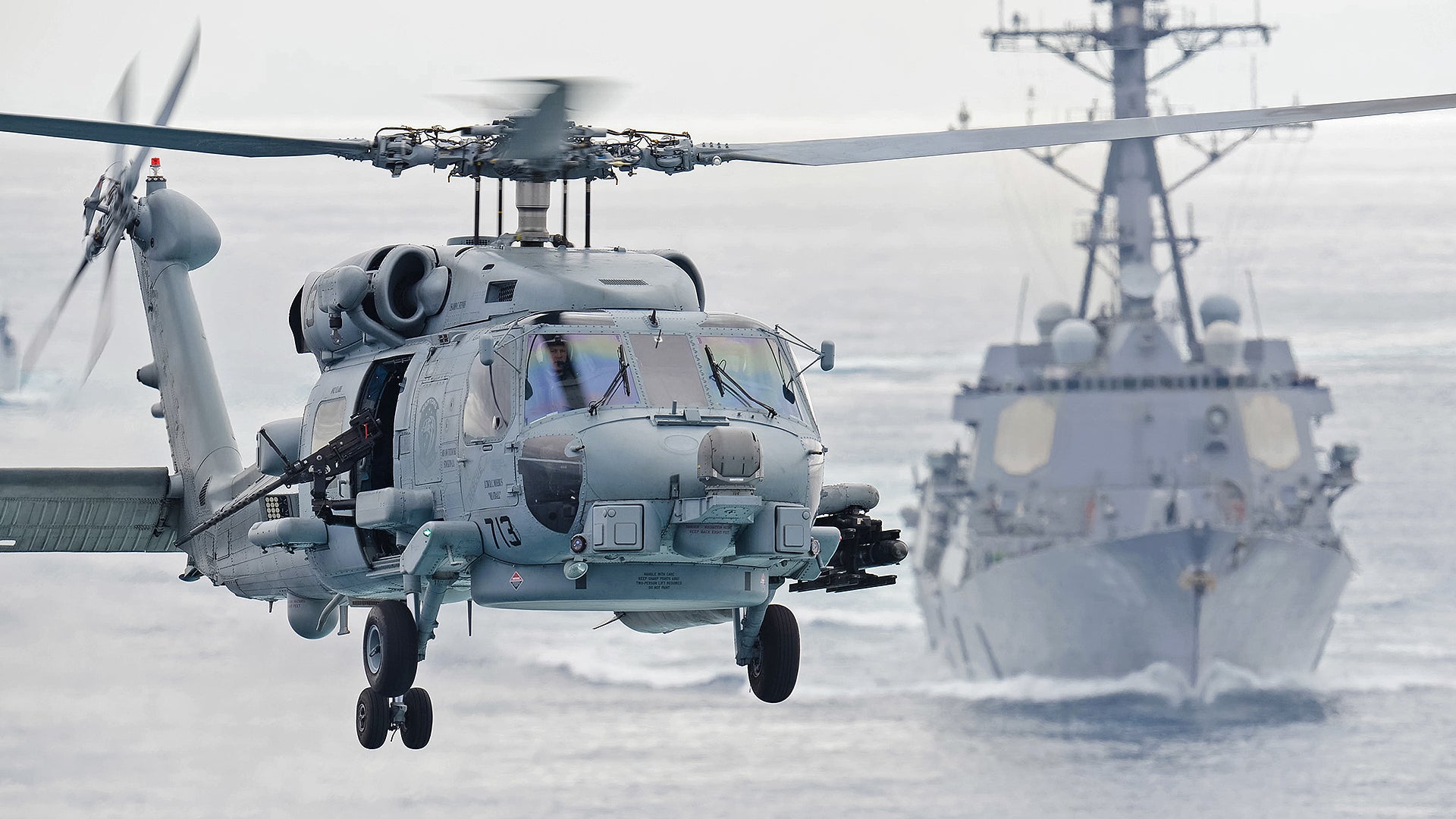The vast majority of helicopters currently operated by the U.S. Navy are either MH-60R or MH-60S variants of the Seahawk airframe, which is a marinized derivative of the UH-60 Blackhawk. These two variants of the Seahawk replaced three previous H-60 airframes in naval service, the SH-60B, SH-60F, and HH-60H. With thousands of hours at the controls of Seahawk helicopters, here are ten interesting facts and impressions based on my experience about flying these iconic aircraft, some of which you may have never heard before.
#1: The Seahawk is a really fun bird to fly
Powered by the GE T700 series of engines, the Seahawk has excellent power margins with extremely rapid transient power response. That’s a convoluted way of saying when you tell the bird to give you more power, it does so quickly. It’s also extremely agile for a helicopter of its size and features an advanced, but user-friendly autopilot system with both barometric and radar altimeter hold functions, which are very useful for long-duration flights at night over water.
The first time I flew in an SH-60F, I was amazed at how responsive the aircraft was, but also how stable it was. It was far easier to control than the much smaller TH-57 trainer version of the Bell Jet Ranger I learned on and presented itself as the perfect blend of power, responsiveness, and stability.

#2: The Seahawk is an extremely safe aircraft
Aviators love to fly aircraft at the limits of the performance envelope. It’s exhilarating to see what pilot and machine are capable of when approaching the extremes of human and mechanical performance. With that said, I always felt very safe operating the Seahawk at or near the operational limits of the airframe.
One of the reasons the Seahawk was such a safe bird to fly was by the time the Navy started flight testing the SH-60B in 1979, the Army, which had started flight testing the UH-60 in the mid-1970s, had already ironed out most of the serious problems with the airframe. By the time I started flying Seahawks in 1994, virtually every systemic mechanical defect had been identified and fixed. In terms of safety, it was truly a mature airframe.
Between 1994 and 2005, I flew just under 3,000 hours in Seahawks. During that time, the only systemic problem that manifested across the Seahawk fleet was a spate of engine rollbacks as a result of the introduction of Digital Electronic Control Units (DECU) for the engines in the mid to late 1990s. An engine rollback is where the Power Control Lever (PCL) is set to full forward, meaning the engine is trimmed to provide full power if required, but in response to a faulty signal from the DECU, the engine abruptly rolls back to an idle power setting. This was a bug of the DECU control system that was quickly identified and fixed, but still hit a number of engines in a relatively short amount of time.
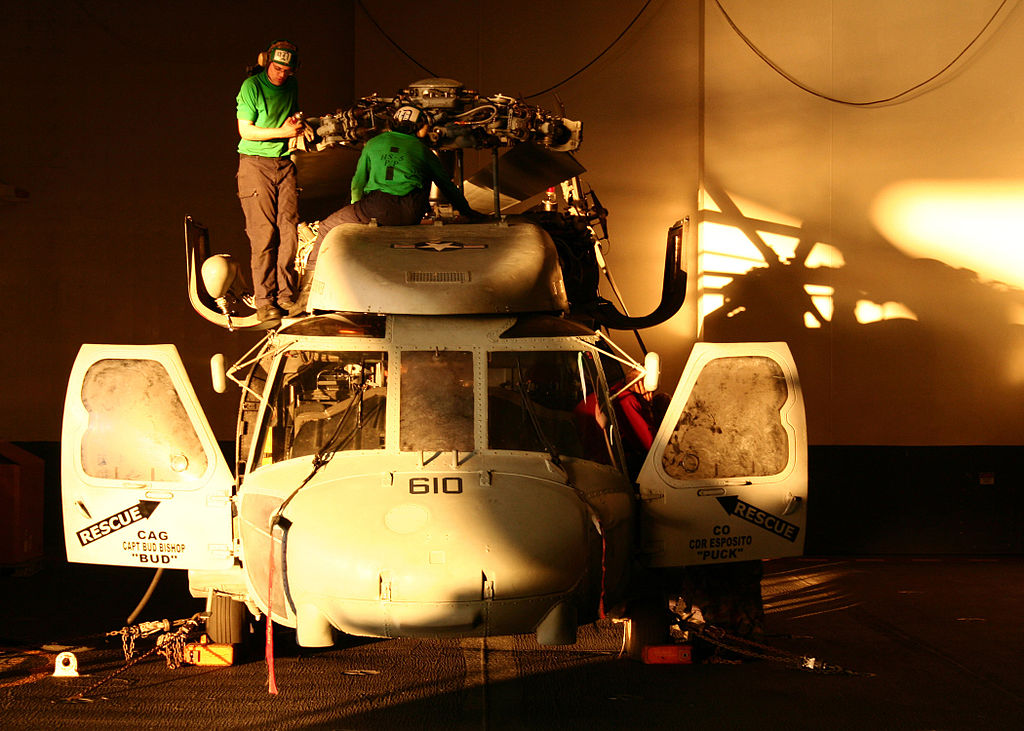
As originally built, the Seahawk engines were equipped with an Engine Control Unit (ECU) that was purely a hydro mechanical control system. Every pilot input from the cockpit to the engine was transmitted via a contact switch, cable, or some other type of electrical or mechanical linkage to the ECU, which in turn governed the engine via analog mechanical inputs. The physical linkages and governing system were very effective, reliable, and safe, but were not fuel efficient and were maintenance intensive. The replacement of the ECU with the DECU was intended to improve fuel efficiency and overall reliability while reducing maintenance requirements. Eventually this was the case, but when first introduced, a number of DECU equipped engines malfunctioned. I was one of the guys who pulled a short straw and wound up flying a DECU equipped engine that suffered an in flight rollback.
It happened just off the coast of Egypt in 1997. I had a full load of internal cargo and passengers, flying into Cairo West in Egypt, a military airport that served as the hub for Operation Bright Star, a semi-annual multinational training event. Two minutes after takeoff, one of the engines suffered a DECU failure and rolled back to flight idle. The other engine had more than enough power for us to keep flying until the carrier could clear the fixed-wing aircraft out of the landing area and give us a clear deck. We executed a bit of a “rolling landing” to minimize the power required for recovery.
When all was said and done, the most remarkable aspect of the emergency was how calm it was. That’s the luxury of having robust engines that churn out a lot of excess power when required.

#3: The Seahawk is amazingly adaptable
The H-60 is an incredibly versatile airframe and Seahawk pilots have to stay proficient on a wide variety of missions. With the SH-60F optimized for ASW missions and the HH-60H optimized for Special Operations (SPECOPS) support, the training requirements seemed to play out on an endless loop. During 2003, in the space of a few months, I flew missions that included supporting Navy SEALS overland in Iraq, with a four-pack of AGM-114 Hellfire missiles on the port side pylon and a .50 caliber machine gun hanging out the starboard cabin door, standing Combat Search and Rescue (CSAR) strip alert, doing search and rescue missions over land and over water, carrying passengers and cargo to and from ship, and dropping torpedoes onto submerged practice targets. There was definitely never a dull day flying Seahawks, as there was always something challenging to train to or do.

#4: Older Seahawks were not built with night vision in mind
Night flying was challenging in the SH-60B and SH-60F because as-built, they were not night vision goggle (NVG) compatible. These two airframes went into production before NVGs were widely available in the fleet, and as a result, the engine instrument panel lights, as well as the warning and caution light panels in the cockpit, were illuminated with amber and red lights instead of NVG friendly blue or green lights.
For the readers who haven’t experienced this, early generation NVGs were susceptible to “blooming out” if yellow or red light came into the field of view. Even a small red light source could completely obscure the field of vision on these earlier model NVGs. To remedy this issue, the Navy issued NVG compatible “glare kits” that were essentially tinted glass panels that could be velcroed over the warning and caution light panel at night to make those lights somewhat NVG compatible.
Flying formation on NVGs in these airframes was also challenging since the standard navigation lights were installed, and were not NVG compatible. As a workaround to this problem, we attached green chemlights at various points around the airframe. While not optimal, this solution did provide for adequate visual reference to enable safe formation flight at night.
In contrast to the SH-60B and SH-60F, the HH-60H was built from the ground up with NVG compatibility in mind. All the instrument displays, as well as the warning and caution lights, were inherently NVG compatible so there was no light blooming in the NVGs. Additionally, the formation lights were NVG compatible as well, which made night formation flying much easier.
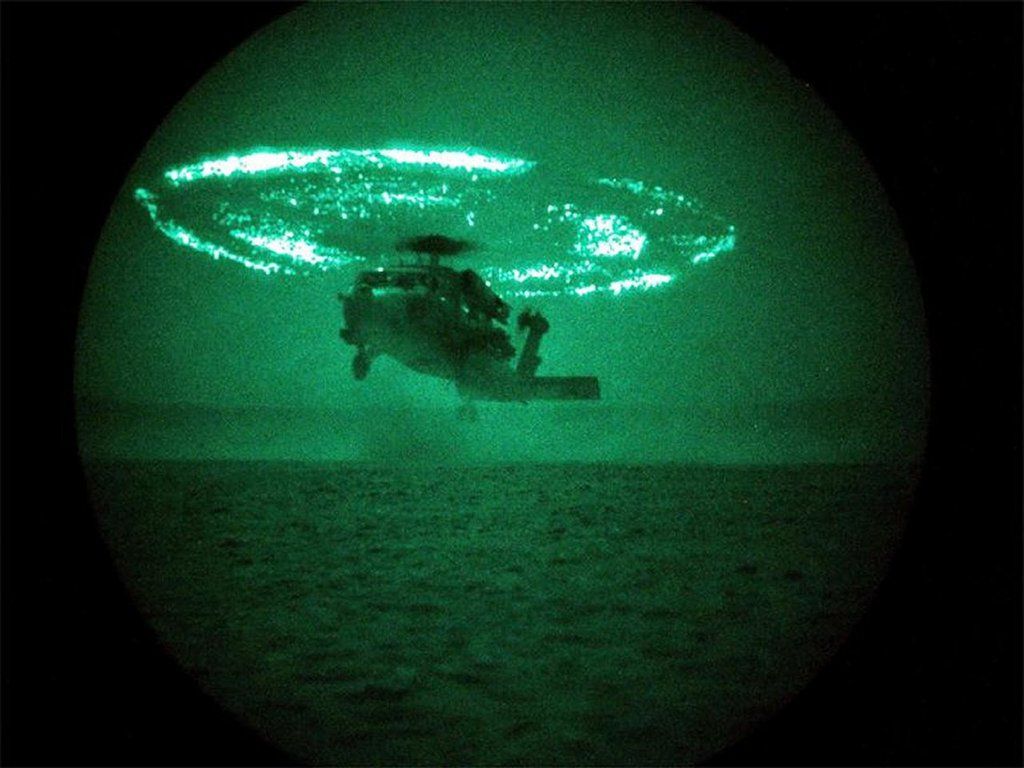
#5: The Seahawk flew higher than its authorized service ceiling
Flying any helicopter at high altitude is an interesting experience, and while the Seahawk has nowhere near the high altitude performance of the CH-47 Chinook, it still can fly a lot higher than the authorized service ceiling of 10,000 feet. Because the H-60 does not have an onboard oxygen system, the Navy limits the maximum altitude to 10,000 feet above sea level as a safety measure, but when flying a lightly loaded Seahawk with no cargo or passengers, and something less than a full load of gas, you can easily get up to 15,000 feet.
At that altitude, the helicopter is sluggish and wallows, so you have to be very careful with control inputs. The engines work fine, but the air is not dense enough to give the rotor blades much “bite”. To be clear, I don’t recommend exceeding any operational or safety limit for any reason, but the fact is, almost every Naval Aviator I knew did so on occasion, usually with good reason.

In one instance, we were headed to the Persian Gulf in January of 2003 aboard the USS Kitty Hawk (CV-63). One of the civilian contractors on the ship had a heart attack and we needed to immediately get him ashore to a hospital. We flew him into Phuket, Thailand, but the carrier was under orders to proceed at best possible speed. So, after we launched heading north and east into Thailand, the ship continued south and west through the Indian Ocean.
We dropped off our medical passenger in Phuket and immediately flew back towards the open ocean, hoping to get in touch with the carrier as soon as possible. The navigation equipment we were using was line-of-sight and at 10,000 feet we were not picking up any signal. The carrier was simply too far away. So, I kept climbing in increments of 500 feet, and eventually, at 14,500 feet we picked up the beacon and rode it home to the carrier, gradually descending all the way.
At that altitude, the helicopter was sluggish and slow to respond, but it was still controllable and safe. Given that my ship and squadron were headed off to a potential conflict zone, I felt like I was justified in exceeding altitude limits in order to get the aircraft and crew back aboard.
#6: The Seahawk does not hover in a level attitude
The normal no wind hover attitude for the SH-60B, SH-60F, and HH-60H was four to five degrees nose up and two to three degrees left wing down. This is slightly disorienting at first. It’s an odd sight picture, so Seahawk pilots quickly learn to incorporate peripheral vision and instrument scan to pick up any drift and establish a steady hover.

#7: Flying the H-60 without hydraulic boost is not a pleasurable experience
On a regular basis, both in the simulator and the aircraft, we trained to respond to two loss of control emergencies, loss of hydraulic boost and loss of Stability Augmentation System (SAS). In the H-60 control system, the pilot inputs through the cyclic and collective are hydraulically boosted before being applied to the rotating and stationary swashplates at the main rotor head. Some smaller helicopters don’t need any hydraulic boost. Some larger helicopters, like the CH-53, are impossible to fly without hydraulic boost. But the Seahawk was right in that sweet spot, where it was possible, but very difficult to fly the aircraft without hydraulic boost. Since this was such a difficult emergency to control, we practiced dealing with it on a regular basis.
Extended flight with hydraulic boost off was simply impossible. Flying the H-60 in boost off mode, especially in a hover, was physically exhausting. With a starboard crosswind, it took 75 pounds of left pedal force to maintain a directionally stable hover. The key was to establish a semi-stable hover as quickly as possible, then land as fast as you could because the longer you stayed in the hover, the more physically demanding it became. 75 pounds of force isn’t a lot, but the requirement to apply that force never goes away. Reducing that force at all will cause the nose of the aircraft to yaw back to the right. That’s just the requirement to control nose yaw with the left pedal. The cyclic and collective inputs are also unboosted.
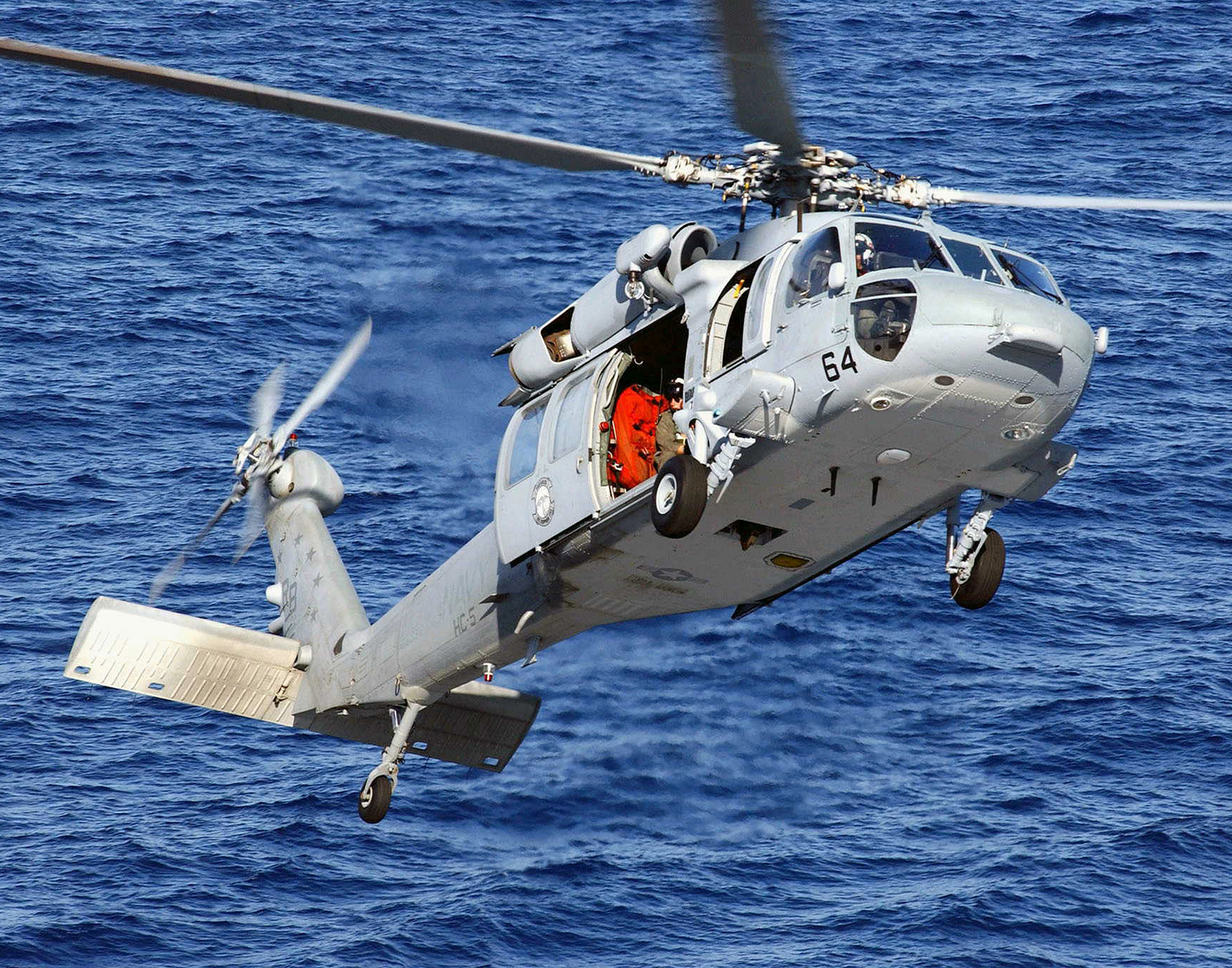
The Seahawk was an incredibly responsive and agile aircraft, in some ways perhaps too responsive. The SAS function essentially “dampened” both the pilot inputs to the control system and external environmental inputs, like wind gusts. Whenever SAS was engaged, the aircraft was more stable. If the SAS function failed, the aircraft was still flightworthy, it just required that the pilot at controls make virtually continuous control inputs via both directional pedals, the collective, and the cyclic.
We often practiced hydraulic boost and SAS failures simultaneously in order to familiarize pilots with how difficult it was to fly under these conditions, and how imperative it was to land as soon as possible. We only practiced this compound, dual emergency in optimal conditions, during daylight, over land, on top of a large, smooth landing area—either a dedicated helicopter landing spot or a smooth grassy field.

#8: The Seahawk cannot refuel in-flight via refueling probe
Several land-based variants of the H-60, like the US Air Force HH-60G Pave Hawk, have in-flight refueling probes where they can get topped off in flight by a C-130 tanker. This is very useful in terms of mission planning as it provides significant operational flexibility. In contrast, Navy Seahawks do not have inflight refueling capability other than Hover In Flight Refuel (HIFR), which is mostly used to extend time on station if the ship’s landing area is fouled with cargo. HIFR doesn’t appreciably extend mission range, either.
With the recent advent of in-flight refuelable E-2D Hawkeyes, every aircraft in the carrier air wing except the MH-60R and MH-60S are now capable of in-flight refueling. That makes fuel planning the first step of every at sea flight for Seahawks.

In the case of the SH-60F, the Navy addressed this at least partially by giving it a massive fuel capacity, with a 590 gallon main tank, 105 gallon permanently installed internal auxiliary tank, and a standard configuration of a single 120 gallon external drop tank, resulting in a total max fuel load of 815 gallons, or approximately 5,500 pounds of gas.
In normal ops, we’d burn about 1,000 pounds an hour, so we would regularly operate with a 5.5 hour endurance at takeoff. In lieu of the permanently installed internal auxiliary tank on the SH-60F, the MH-60S is configured to take removable internal auxiliary tanks as required. This makes internal cargo and passenger operations in the MH-60S much more convenient if the internal auxiliary fuel tanks are not installed. Because the MH-60R has such extensive internal mission equipment, it is unable to take internal auxiliary fuel tanks, but has hardpoints and plumbing for two external drop tanks.
In any case, running out of gas in a helicopter over land is not nearly as exciting as running out of gas in a helicopter over the ocean, so normal practice at sea was to get gas at every ship we landed on, regardless of our final destination.

#9: Most the Seahawks have an odd tailwheel placement
The SH-60B, SH-60F, and HH-60H had a very odd tailwheel placement, located just aft of the main cabin. The MH-60R was also produced with that tailwheel placement. Shipboard landings, especially on smaller surface combatants, place a significant amount of stress on the airframe. Positioning the tailwheel closer to the rotor head reduces the stress on the tail boom. The MH-60S, however, has its tailwheel located in the same place as the Army and Air Force H-60s, at the far aft end of the airframe.
One of the advantages of having a tailwheel located just aft of the main cabin was, it yielded an incredibly tight turning radius, which is very useful for ground crews using tugs to maneuver the helicopter on congested flight decks. Some Naval Aviators are apparently still struggling to master the correspondingly larger radius of turn associated with a long tailwheel placement.

#10: Seahawk has become a jack of all trades, but one, at least yet
While the H-60 is now the one size fits all solution to every Navy helicopter mission except airborne minesweeping, which is still the sole purview of the relatively small and chronically overtasked MH-53 fleet, it didn’t start out that way. The first H-60 variant the Navy procured was the SH-60B, which replaced the SH-2 Seasprite as the anti-submarine warfare (ASW) helicopter operating off of US Navy surface combatants in the Light Airborne Multi-Purpose System (LAMPS) role. It was several years later, in the mid-1980s, that the Navy started investigating replacements for the carrier-based SH-3 Sea King fleet. Eventually, the SH-60F was selected as the ASW helicopter operating off of carriers and was procured en masse starting in the late 1980s.

The SH-60B was designed as an over the horizon extension of the surface ship’s surveillance sensors. The primary sensor it carried was a surface search radar. Operating at altitudes up to 10,000 feet, the SH-60B could surveil thousands of square miles of the ocean’s surface and instantly transmit that data back to the surface ship. In contrast, the SH-60F was designed to provide inner zone defense against submarines for the carrier and was equipped with a powerful dipping sonar that could track submarines and provide targeting data for air or surface-launched torpedoes. Both versions of the Seahawk also carried expendable sonobuoys, which detect and track submarines by passive and active sonar sensors.
After the early success of the SH-60B and SH-60F Seahawks, the Navy expanded the model even further by procuring the HH-60H for Naval Special Warfare (NSW) support starting in the early 1990s. By the mid-1990s the Navy decided to divest itself of all legacy rotary wing airframes, including the UH-1 Huey, the SH-2 Seasprite, the SH-3 Sea King, and the CH-46 Sea Knight.

As far as the next generation of Seahawks, the MH-60R is equipped with cutting edge surveillance and data transmission capability. Even though the MH-60R is based on an airframe design that is quickly approaching the half-century mark in age, its mission equipment is brand new, making it the most technologically advanced Anti-Submarine Warfare (ASW) and Anti-Surface Warfare (ASuW) helicopter in the world today. It is equipped with a dizzying array of advanced sensors and weapons that enable it to search, locate, track, and engage targets above and below the sea surface.
Like its SH-60B predecessor, everything the MH-60R detects is immediately transmitted back to the ship via the Common Data Link (CDL) Hawklink. That data is collected by a variety of sensors including the AAS-44 Forward-Looking Infrared (FLIR), the APS-147 multi-mode radar with Synthetic Aperture Radar (SAR) imaging and periscope detection modes, the AQS-22 Airborne Low Frequency Sonar (ALFS), and the ALQ-210 Electronic Support Measures (ESM) system for passive detection, location ,and identification of RF emitters. In addition to the onboard sensors, the MH-60R can also carry expendable sonobuoys for detecting and tracking submarines. Finally, in addition to all the sensors, the MH-60 packs a powerful punch with the ability to carry lightweight torpedoes, Hellfire missiles, and door-mounted machine guns.
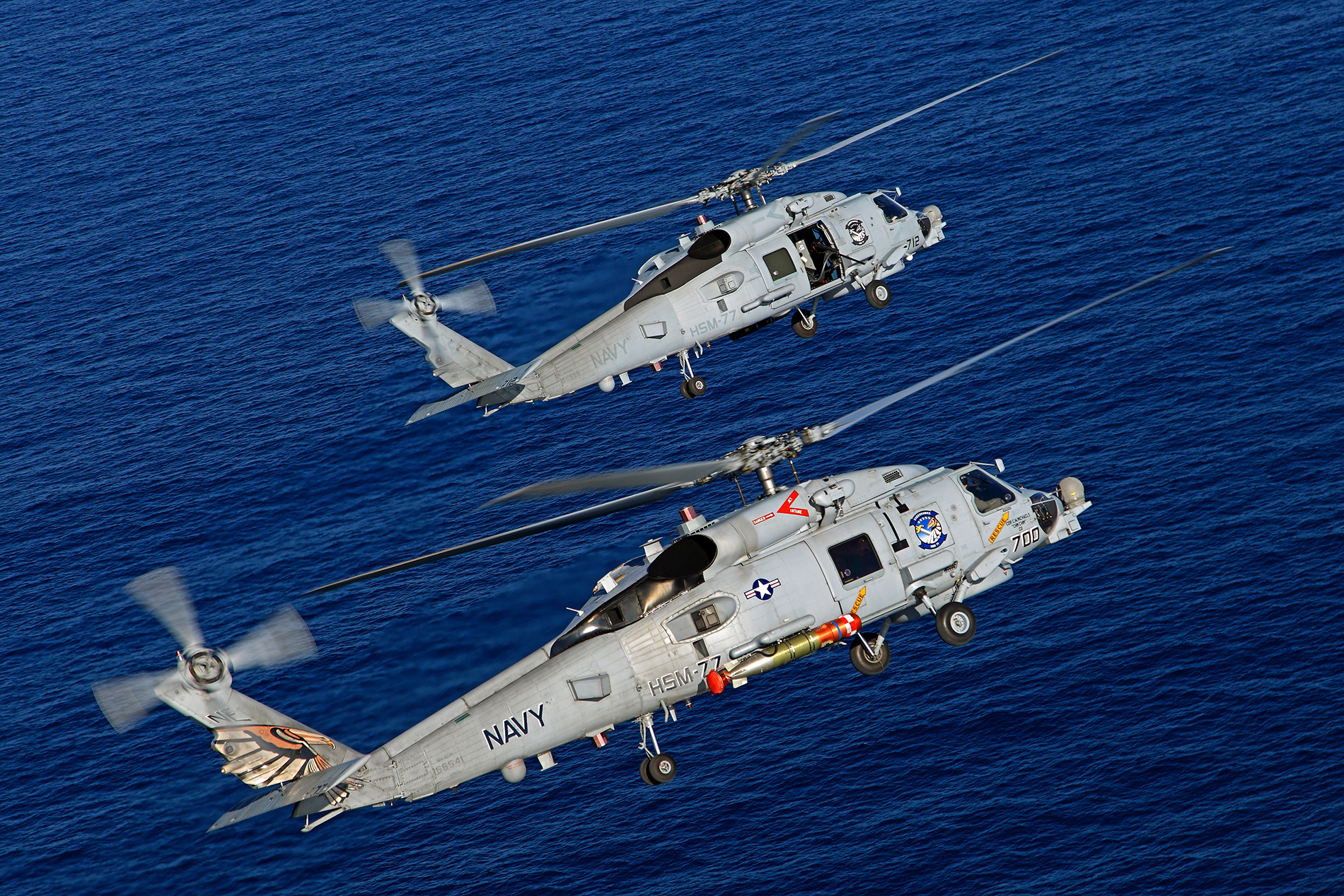
In contrast to the ASW and ASuW mission of the MH-60R, the MH-60S is essentially a flying truck, with the ability to carry cargo both internally or externally via sling load. With a secondary mission of Search and Rescue (SAR), the MH-60S has plenty of internal room to carry rescue swimmers and medical personnel. In a design nod to supporting special operations, the MH-60S was built with the same dedicated door gunner window stations that the Army H-60 Blackhawks have, so the cargo doors on both sides can be used to onload and offload personnel at the same time door gunners are laying down suppressing fire via the window stations.
Overall, the MH-60S has much less advanced equipment than the MH-60R, but it does have one very unique and highly advanced piece of equipment, the Airborne Laser Mine Detection System (ALMDS). Along with its logistic and SAR roles, the MH-60S was also originally intended to replace the MH-53 Sea Dragon in its role as an airborne minesweeper, pulling a sled that detected, disabled, or detonated mines. Unfortunately, the minesweeping equipment that the MH-53 operated with ease was just too big for the MH-60S and other towed solutions have not panned out, so instead of using towed equipment, the MH-60S uses the ALMDS to perform the mine detection part of the mission.

It’s been 40 years since the Navy made the first test flight of an SH-60B in 1979 and the Seahawk remains a great aircraft to this day. With the fleet full of new build advanced MH-60R and MH-60S types, it will be around for at least another 20 years, and probably much longer.
Contact the editor: Tyler@thedrive.com
